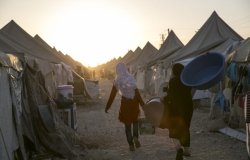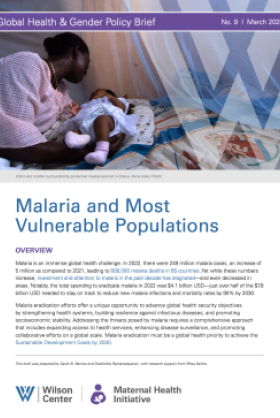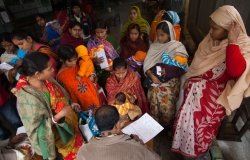Media, M.D.
“The increased media spotlight could affect the government's approach to funding, research, and communication about prevention [of diseases]-- shifts that could potentially impact thousands of lives annually,” writes David Rejeski.
After almost two months of screaming newspaper headlines and wall-to-wall cable television coverage about the Ebola outbreak, a calm descended over the media in late October. On Oct. 30, the Washington Post's front page carried the headline, "New Cases of Ebola Declining, WHO Says." The next day, the same real estate carried stories about the war in Syria and the CEO of Apple, Inc. Over the same two days, Ebola was nowhere to be found on the front page of the New York Times. It was 23 days after the death of Thomas Eric Duncan, the first and only confirmed Ebola fatality in the United States.
Barring another victim arriving on U.S. shores, this slowdown in Ebola stories could be the start of a downward slope often seen in coverage of new, scary viral outbreaks. Coverage of epidemics often tracks well initially with the number of reported cases, with media attention waning in the aftermath of the initial outbreak. But these spikes stand in stark contrast to how the media covers chronic diseases and other health problems with huge human and economic costs to society. Despite far-reaching effects, these stories rarely find the media spotlight.
This trend is borne out in a recent analysis undertook by the Wilson Center, which looked at more than a decade of reporting on diseases -- from HIV to tuberculosis and diabetes -- in the Post and the Times. For example, influenza saw Ebola-like spikes in coverage in 2006 and 2009, fueled by outbreaks of "bird flu" and "swine flu." More generally, HIV/AIDS saw numerous spikes in coverage throughout the 1990s and early 2000s. These initial spikes in media coverage are often followed by a quick descent into what one former AIDS reporter termed the "inert space of journalistic fatigue."
But many of the costliest diseases facing society barely register above the background noise. These are the sort of issues doctors and health professionals have been warning us about for years. Almost 30 million people in the United States have diabetes, resulting in around $250 billion in medical costs and lost work and wages annually, according to the Centers for Disease Control and Prevention. A recent report by the Rush University Medical Center indicated that in a single year Alzheimer's was responsible for 636,000 deaths in this country (killing more people than AIDS has done in three decades). Flu kills more than 35,000 Americans per year, but only gets front-page attention when associated with a spreading pandemic. Even Ebola, the focus of so much angst of late, barely registered as a blip in the press despite outbreaks in 1995 (315 deaths), 2000 (425 deaths), and 2003 (143 deaths).
Of course, journalists by their very nature tend to focus on events, rather than issues. After all, what is news if not information about recent, important events? But the media is also an important part of our public health system -- not just an outside observer.
In her book Selling Science, sociologist Dorothy Nelkin made the point that the public often understands complex issues not through direct experience or past education but through the filter of newspapers, television news, magazines, and websites. Or, as the popular adage goes: The press doesn't tell the public how to think, but what to think about. How the media covers public health matters, especially if media coverage shifts political attention or the allocation of scarce human and financial resources.
Earlier this month, Times executive editor Dean Baquet told the Post that, despite not giving the story much play in the early days of the outbreak, the eventual media coverage did force the government to act. "As it was, I would argue that the press moved more quickly than the government. I think you could make the case that we did influence the government," Baquet said.
Imagine if some of that media pressure was more equally applied to "forgotten" health issues -- problems that are not front-page news because of the prevalence of the disease or how it is viewed by society. The increased media spotlight could affect the government's approach to funding, research, and communication about prevention -- shifts that could potentially impact thousands of lives annually.
Coverage of Ebola seems to be slipping. Quarantines are expiring, revised guidelines have been established, and stronger protections are now in place. Assuming we get this outbreak under control, what is likely to happen next? Press coverage will dissipate, the sales of Richard Preston's 1994 book The Hot Zone will drop off (though we may get a movie out of this), and complacency will once again replace vigilance. Then the media will understandably redouble its focus on Ebola during the next outbreak (not to mention plenty of false alarms once flu season rolls around).
But better balanced coverage could disrupt this cycle, where outbreaks receive short-term, hyperbolic bursts of coverage and ongoing, chronic issues rarely get covered despite their outsized impacts. This manic rhythm will persist as long as we continue to believe that our public health system is in the hands of doctors and public health officials when in fact the system also includes a powerful partner in the ever-fickle news media.
The opinions expressed here are solely those of the author.
This article was originally published by The Huffington Post.
About the Author

David Rejeski
Former Director, Science and Technology Innovation Program, Wilson Center

Science and Technology Innovation Program
The Science and Technology Innovation Program (STIP) serves as the bridge between technologists, policymakers, industry, and global stakeholders. Read more

Science and Technology Innovation Program
The Science and Technology Innovation Program (STIP) serves as the bridge between technologists, policymakers, industry, and global stakeholders. Read more











